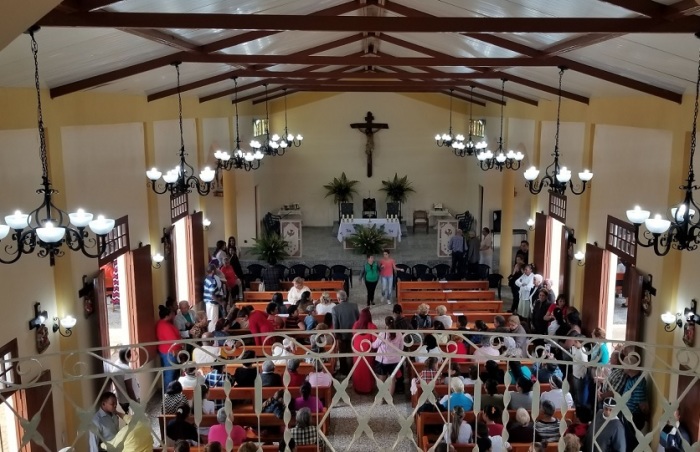First Catholic church built in Cuba since revolution opens, brings a 'new sign of faith'

The first new Catholic church to be built in Cuba in over 60 years opened its doors Saturday in the rural town of Sandino, providing what some say is “a new sign of faith” in the socialist country.
With the help of a parish in Tampa, Florida, the Sacred Heart of Jesus Parish became the first of three new parishes to be completed across the island nation.
The bright yellow church that seats about 200 people is the first Catholic parish to be dedicated since the days of the Cuban Revolution and the revolutionary government’s crackdown on organized religion.
The project came to be thanks to a fundraising campaign launched by St. Lawrence Parish in Tampa that raised over $95,000 to cover much of the construction costs.
“It was incredible to see the church that was built by a small but faith-filled community in Sandino,” Father Chuck Dornquast, the parochial vicar of St. Lawrence Parish, said in a statement. “While the church seats 200 people, it’s estimated that nearly 500 people attended the dedication.”
According to the Diocese of St. Petersburg, Catholic Schools were closed and many priests and religious communities were exiled following the Cuban Revolution. Additionally, public expressions of faith “became taboo.”
A move toward more tolerance of some public expressions of faith started in the 1990s when Pope John Paul II celebrated mass in Cuba with thousands of believers. Also in the 1990s, the Communist Party removed atheism as one of the membership requirements.
Although Cuba remains a secular state, the communist government has become much more tolerant of Christianity.
The Diocese explained in a press release that Catholics in Sandino, a town on the very northwest end of the island, had previously held mass and Bible studies and other gatherings at their homes. The community expects that the new building will bring more people and strengthen their congregation.
“Christ has placed the call to make disciples in each of us, whatever our circumstances,” Dornquast added. “People in this tiny town of Cuba are finding a way to live out that call, despite their difficult circumstances.”
The priest who oversaw the construction, Cirilo Castro, told CNN that with the warming relations between the communist government and the Vatican, he “knew it would happen one day."
"To see this finished is like coming out of the night into the day," Castro explained.
Because construction materials are hard to come by on the island, the construction took about four years.
"From the day they put the first stone we have been watching it grow little by little,” Sandino resident Aleida Padrón Zabala told the news outlet. “Patience has given us this church.”
Two other Catholic parishes are being constructed in Havana and Santiago.
According to the U.S. Commission on International Religious Freedom, around 60 to 70 percent of Cuba’s 11 million people are Catholic while five percent are Protestant.
Although the Cuban government is warming up to religion, USCIRF warns that religious freedom conditions in the country are still “poor” despite the existence of 55 registered religious communities.
The country was listed by the federal government watchdog entity as a “Tier 2” country of concern for religious freedom in its annual report last year. USCIRF said that the Cuban government has engaged in “harassment campaigns that included detentions and repeated interrogations targeting religious leaders and activists who advocate for religious freedom.”
William Devlin, an evangelical New York City pastor, recently traveled to Cuba for the 40th time since 2007.
“[I have] never had a problem with government nor [have] the thousands of pastors, missionaries and evangelists that I’ve taught and been to a conference with,” Devlin, a Navy veteran and Purple Heart recipient, told The Christian Post Wednesday.
“The Cuban evangelical church is experiencing significant growth,” he added. “The pastors are free to preach the Gospel.”
Last week, Devlin met with a pastor of one of the largest churches in Holguin, one of the largest cities in Cuba, about trying to make Cuba a “sending country.” He said that a group of about 20 Cuban Christians from the church expressed a desire to train to become missionaries to the Middle East. Fluent in Arabic, Devlin is prepared to beginning training this group.
Follow Samuel Smith on Twitter: @IamSamSmith
or Facebook: SamuelSmithCP





























